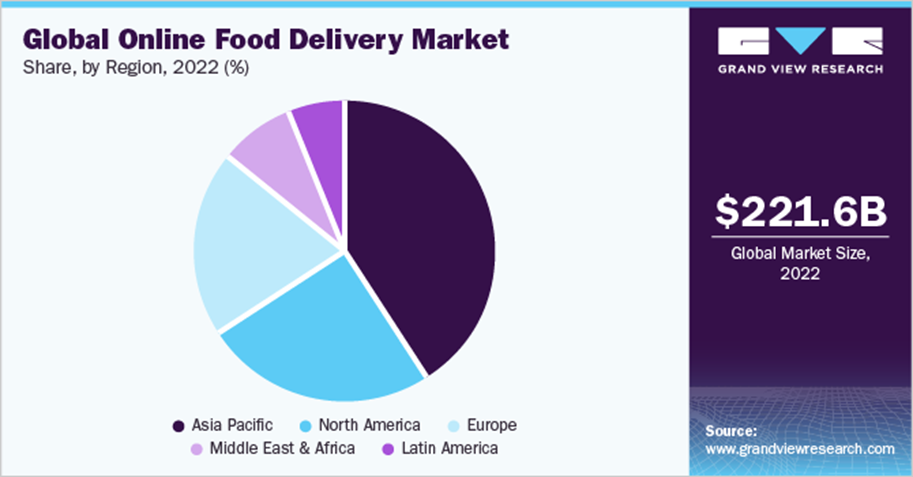USA has DoorDash and UberEATS
UK has Just Eats, Deliveroo
Canada has to Skip the Dishes.
India has Swiggy and Zomato
Every country has its version of the food delivery app.
Online food delivery apps have won millions of customers' hearts (and downloads).
The food delivery industry is growing at a fast rate. Hence, it's the golden time for food delivery app development.
Apps like Deliveroo have proved that you can penetrate the industry by thinking out of the box.
Accordingly, read on if you want to build a food delivery app and need help with the tech stack and development costs.
Let's begin with some interesting statistics about the food industry.
|
Statistics on Food Delivery Industry
By 2029, food delivery will reach $320 billion. Growth was the largest in five years in 2020 because of Coronavirus.
|
Food Delivery App Models
Choosing a profitable model requires profoundly understanding your customer's pain points. So let us get to it. To begin with, the food delivery app has two core models:
- Order-only business model: The restaurant manages its delivery. App only manages to order. E.g., Dominos.
- Order with the delivery business model: Aggregators handle delivery, not the restaurants. E.g., Uber Eats.
Food Delivery Tech Stack
Before we discuss the Food Delivery Tech Stack, it's essential to understand what features customers are looking for in an app because your tech stack will depend on the features and customizations needed.
- Customer app: This should allow users to search nearby restaurants, create profiles, search filters, deliver tracking, and push notifications.
- Delivery app: provides access to GPS, registration, order status, push notifications, and history of delivered orders
- Restaurant app: this app is for restaurants that can list their menus, create campaigns, and communicate with delivery persons and customers.
Now that we know the basic models of food delivery apps, here's what the tech stack will look like.
Tech Stack for Food Delivery App
Frontend:
Frontend is usually divided into Android and iOS.
- For Android: Java or Kotlin are commonly used as foundation languages. Android Studio uses an IDE and XML or Android Studio's layout editor to design the user interface.
- For iOS: Swift is the primary language for iOS app development. Whereas Xcode is the official IDE and interface builder for UI design.
Backend:
Python, Ruby on Rails, Node.js, and Java are backend languages for building apps. Web frameworks are also used to streamline development and provide built-in functionality. E.g., Django. Express, Flask.
For large apps, usually, cloud platforms are used to provide scalability and flexibility. Examples include Amazon Web Services (AWS), Microsoft Azure, and Google Cloud Platform.
Apart from the front and back end, several customizations are needed in an app. Below are the standard tech stacks used to customize food delivery apps.
Customizations Used for Food Delivery Apps:
|
For Payments |
Stripe, Braintree, PayPal, Apple Pay |
|
For location Finding |
Google Maps API, OpenStreetMap and Mapbox. |
|
For Registrations |
Facebook or Gmail SDK |
|
Storage |
MySQL, PostgreSQL, or NoSQL databases like MongoDB. |
|
Analytics |
Google Analytics, Mixpanel, Amplitude, Firebase |
|
Messaging Service |
Twilio, Pusher, and Firebase Cloud Messaging. |
|
API |
Django REST Framework, Flask-RESTful, and Express. |
Cost is the next and crucial deciding factor while developing a food delivery app. The table below gives an indicative cost breakdown of developing a food delivery app.
Food Delivery App Development Cost (Associated with Each Stage)
|
Phases |
Substages |
Cost Estimates |
|
Research and Planning |
Market research to identify user needs. Analyze competitor apps to identify their strengths and weaknesses. |
$500-$2,000.
|
|
Identify the app's essential features, such as order tracking, payment integration, and menu browsing. |
$2,000-$5,000. |
|
|
Create a project plan that outlines the development process, timelines, and budget |
$1,000-$3,000.
|
|
|
Design |
Wireframing: Design low-fidelity wireframes to outline the app's structure and user flow. |
$1,000-$3,000 |
|
Create high-fidelity designs for the app's UI and UX. |
$3,000-$10,000. |
|
|
App development |
Backend development: Develop the app's server-side logic, APIs, and database. |
$15,000-$40,000 |
|
Frontend development: Develop the app's UI using your chosen programming language and framework. |
$10,000-$25,000.
|
|
|
Third-party integration: Integrate third-party services like payment gateways, SMS gateways, and push notification services. |
$5,000-$10,000. |
|
|
Testing |
Test individual components and functions, app's integration with third-party services, and app's functionality and usability with real users |
$10,000.- $20,000. |
One needs to consider the monetization models after deciding on the tech stack. After all, no one wants to build an app that doesn't make money.
Let's Look at the Top 4 Monetization Opportunities for Food Delivery Apps:
Delivery fees
Delivery fees are charged based on location and timing and distributed between the app and the delivery driver.
|
Food Delivery Apps |
Delivery Fees |
|
UberEats |
Flat rate of $4.99. Charges increase depending on the distance. |
|
DoorDash |
$0.99 to $7.99 + 7–15% service fee per order |
|
Grubhub |
Standard $9.99 delivery fee |
Advertising
Popular apps like Grubhub also earn from in-app ads. For example, restaurants can pay extra to feature themselves at the top of search results for a specific time.
Subscription
You can provide subscription plans which give users more perks than a free account. E.g., Swiggy in India offers subscription plans where you get free delivery irrespective of the distance. Zomato Gold club subscription provides a host of benefits to its members, like discounts at partnering restaurants, free delivery promos, etc.,
Commission
Lastly, food delivery apps can earn by charging fixed commissions. E.g., Just Eat generates massive revenue by charging restaurants commissions on transactions.
Ready to build your food delivery app?
Online food delivery is a growing industry. As per market estimates, the global online food delivery market is expected to grow at a compound annual growth rate of 10.3% by 2030 and reach USD 505.50 billion by 2030.
There are many opportunities and loopholes that you can exploit to create a top delivery app for your startup or company. So, if you're looking for an app development company to build your food delivery app, ensure they have experience working on similar projects. Your app will have a seamless user interface and a user experience that makes it easy to use, which can help you take advantage of the business model that suits your needs best.
Here is where Clarion Technologies can give you an advantage. Our team of highly skilled mobile app developers can help you build an innovative food delivery app that will wow your customers and increase sales. To hire developers at Clarion Technologies and get an estimate for your app idea.
Author





